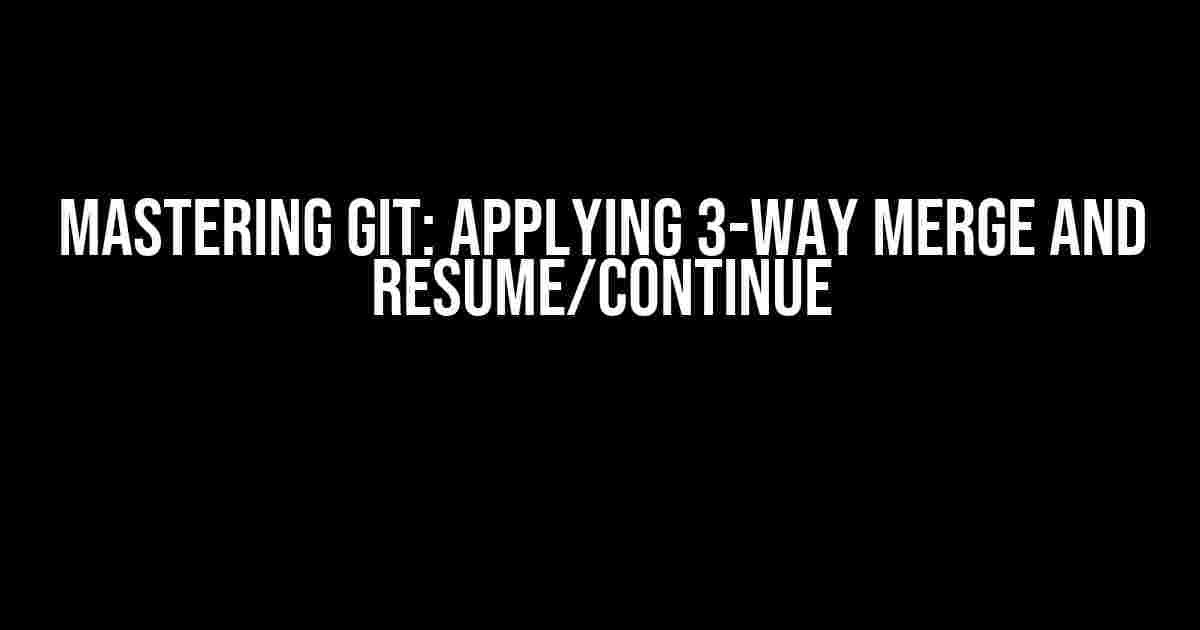Welcome to the world of Git, where version control meets genius-level problem-solving skills! In this article, we’re going to dive into the fascinating realm of 3-way merge and resume/continue, demystifying the secrets of Git’s most powerful features.
What is a 3-Way Merge?
A 3-way merge is a Git merge strategy that combines the benefits of two-parent merges with the flexibility of manual conflict resolution. When two developers work on the same codebase, they might introduce changes that conflict with each other. A 3-way merge helps resolve these conflicts by creating a new merge commit that combines the changes from both branches.
The Magic Behind 3-Way Merge
Here’s how it works:
- Git creates a new merge commit: Git creates a new commit that combines the changes from both branches (typically
masterand a feature branch). - Three-way merge algorithm: Git uses a sophisticated algorithm to identify the differences between the two branches and creates a new file that reflects the changes.
- Conflict resolution: If there are conflicts, Git marks them in the file and stops the merge process, allowing you to resolve the conflicts manually.
How to Apply 3-Way Merge
Now that we’ve covered the basics, let’s get to the practical part! Applying a 3-way merge involves a few simple steps:
git checkout master: Switch to the main branch (usuallymaster) where you want to apply the changes.git merge --no-commit feature/branch: Merge the feature branch into the main branch using the--no-commitflag to prevent Git from creating a new merge commit automatically.git status: Verify that the merge is in progress and review the changes.- Resolve conflicts (if any): Use your favorite editor to resolve any conflicts marked by Git.
git add .: Stage the resolved changes.git commit -m "Merge feature/branch into master": Create a new merge commit with a meaningful commit message.
$ git checkout master $ git merge --no-commit feature/branch $ git status $ # Resolve conflicts (if any) $ git add . $ git commit -m "Merge feature/branch into master"
Resume/Continue Merge
What happens when you’re in the middle of a merge and need to stop or pause the process? That’s where git merge --continue comes to the rescue!
When to Use Resume/Continue Merge
You can use git merge --continue in the following scenarios:
- Resume a paused merge: If you need to stop the merge process temporarily, use
git merge --continueto resume where you left off. - Re-attempt a failed merge: If the merge fails due to conflicts or other issues, use
git merge --continueto re-attempt the merge.
How to Use Resume/Continue Merge
To continue a paused or failed merge, simply run:
$ git merge --continue
This will restart the merge process from where you left off. If you’re dealing with conflicts, Git will mark them again, and you can resolve them as usual.
Tips and Tricks
Here are some additional tips to help you master 3-way merge and resume/continue:
| Tips | Description |
|---|---|
Use git status |
To verify the merge status and identify conflicts. |
Use gitk --all |
To visualize the commit graph and track the merge progress. |
Use git merge --abort |
To cancel the merge process and return to the previous state. |
Use git config merge.conflictstyle |
To customize the conflict resolution style (e.g., merge, diff3, or mingle). |
Conclusion
Mastering 3-way merge and resume/continue is an essential skill for any Git user. By following the steps and tips outlined in this article, you’ll be able to navigate even the most complex merge scenarios with ease. Remember, practice makes perfect, so go ahead and give it a try!
Happy merging, and don’t forget to git commit your progress!
This article is optimized for the keyword “git apply 3 way merge and resume/continue”. If you have any questions or need further clarification, feel free to ask in the comments below!
Frequently Asked Question
Get ready to resolve those pesky merge conflicts with Git’s powerful 3-way merge and resume/continue features!
What is a 3-way merge in Git?
A 3-way merge in Git is a process that combines three versions of a file: the common ancestor, the current version, and the version to be merged. This allows Git to intelligently resolve conflicts by comparing the changes made in all three versions, making it easier to merge branches.
How does Git’s 3-way merge handle conflicts?
When a conflict arises during a 3-way merge, Git will pause the merge process and allow you to manually resolve the conflict. You can edit the file to merge the changes, and then commit the resolved file. Git will then resume the merge process from where it left off.
What is the difference between ‘git merge –abort’ and ‘git merge –continue’?
‘git merge –abort’ aborts the merge process and reverts the repository to its pre-merge state. On the other hand, ‘git merge –continue’ resumes the merge process after you’ve resolved the conflicts and committed the changes.
Can I use ‘git apply’ to merge changes from a patch file?
Yes, you can use ‘git apply’ to merge changes from a patch file. ‘git apply’ applies the patch file to your current branch, and if there are conflicts, it will pause and allow you to resolve them manually. Once resolved, you can commit the changes.
How do I resume a failed merge using ‘git apply’?
If ‘git apply’ fails to apply a patch due to conflicts, you can resolve the conflicts and then use ‘git apply –continue’ to resume the application of the patch. This will apply the remaining changes from the patch file.


